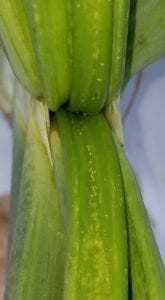Agronomic Crops
This week was a good week for crop growth and development. We are now seeing V6 to V8 corn and soybeans reaching V2-V3 in most
areas. As the crops continue to progress, they become more tolerant of early insect pests like cutworms and slugs. Overall, there are not many concerns with our agronomic crops at this point in the season. We are, however, starting to see the arrival of some more common summer pests.
Japanese beetles have started to make their presence known in corn and soybean fields across the area. We are also finding an increasing number of grasshoppers, especially in soybean fields. This week we also noted our first sighting of Northern Corn Leaf Blight.
In alfalfa, we have not observed any large counts of potato leaf hoppers to this point. There are a few out there, but nothing has been over threshold so far.
Vegetable Crops
Imported cabbage worm butterflies are laying a lot of eggs on cole crops. It is important to scout the crops for the eggs as well as the larvae, in order to have a better grasp on when the larvae are hatching and causing damage. This will also help ensure efficient and timely insecticide applications.
Aphids are continuing to be present in many of the vegetable crops that our IPM program scouts,
however, we are finding a lot of beneficial insects that are feeding on the aphids and helping to either maintain or eliminate populations. Japanese beetles also are present now in many of the crops in our area.
This week was also the first week that we really noticed an increase in thrips in onion plants. As the leaves get larger and offer more shelter for the thrips, the populations are able to multiply rapidly.
Some sweet corn in the area is tasseling, silking and in some cases, nearing harvest. We have noted some European Corn Borer feeding in tassels. If 10% of silking plants are damaged by ECB, a treatment is warranted. In some fields, this threshold was met, and growers started on a spray program for their tasseling and silking corn.
Small Fruit and Orchards
Aphids in the apple trees continued to be the main pest this week. We found more clusters of wooly apple aphids, which are now working their way out onto the new shoots and green growth. Our trap counts for OFM remain well below threshold.
OFM traps in peach blocks were also well below threshold, however, we did see an increase in the trap counts of Greater and Lesser Peach Tree Borer.
Strawberry season is winding down. Our SWD traps in strawberry patches yielded 0 SWD. Harvest is starting in some area blueberry and bramble patches. Grape clusters are developing nicely and starting to put on some size.
























